International Journal of Engineering Research and Reviews ISSN 2348-697X (Online)
Vol. 10, Issue 3, pp: (33-37), Month: July - September 2022, Available at: www.researchpublish.com

International Journal of Engineering Research and Reviews ISSN 2348-697X (Online)
Vol. 10, Issue 3, pp: (33-37), Month: July - September 2022, Available at: www.researchpublish.com
Pipeline Projects Department
DOI: https://doi.org/10.5281/zenodo.7072363
Published Date: 12-September-2022
Abstract: The Master Gas System (MGS) Phase 2 Pipeline project has entered its final construction stage of Mechanical Pre-commissioning of the 56” pipeline. The project pre-commissioning of the pipeline has commenced at all 3 major packages (Eastern, Central, and Western) areas. Pipeline pre-commissioning activities consist of several activities from mechanical cleaning, gauging, hydrotesting, dewatering, and chemical cleaning. Mechanical cleaning of debris, hydrotesting to check strength, dewatering of used chemically treated water, and chemical cleaning and preservation are critical activities that must be performed effectively before the pipeline is put in service. Utilization of different types of scrapers like foam, bi-directional, brush, intelligent, etc. are some critical tools to help in the pre-commissioning stage. After completion of all these activities, the pipeline will be re-instated with all required valves and will be preserved with nitrogen to make it ready for operation use
Keywords: Pre-Commissioning, Mechanical Cleaning, Scrapers, Debris, Nitrogen, Strength, Tightness, Chemical cleaning,
The Master Gas System (MGS) Phase 2 Pipeline project has entered its final construction stage of Mechanical Precommissioning of the 56” pipeline. The project consists of around 850 km of 56” and 46” pipelines, which complement the already constructed MGS phase 1 project, to transport natural gas from Eastern to Central and Western regions of Saudi Arabia. The project construction is in its advanced stage andmechanical pre-commissioning of the pipeline has commenced at all 3 major packages (Eastern, Central, and Western) areas. Pipeline pre-commissioning activities consist of several activities from mechanical cleaning, gauging, hydrotesting, dewatering, and chemical cleaning.
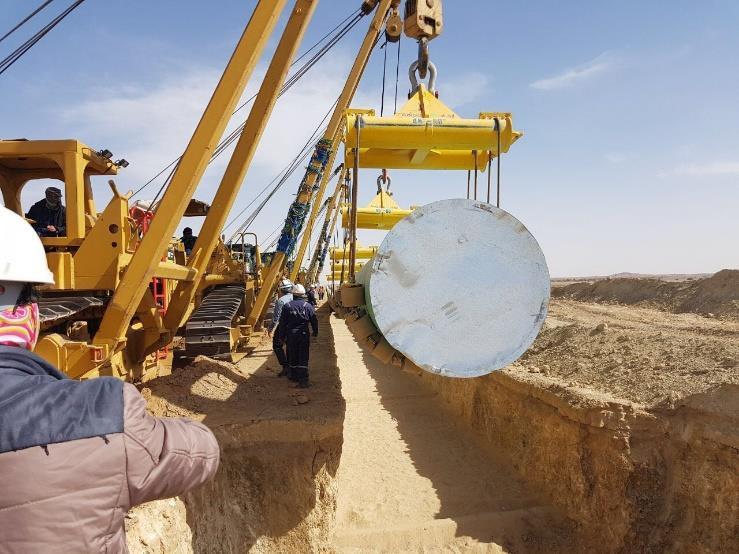
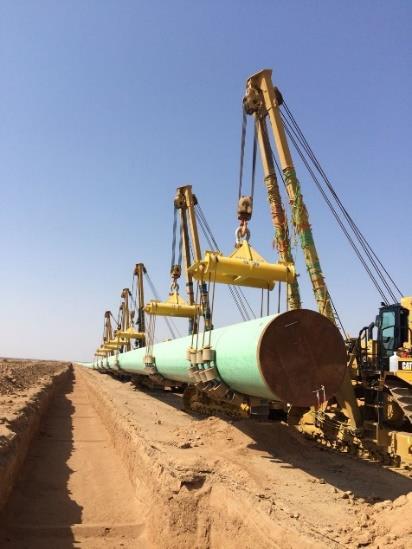
International Journal of Engineering Research and Reviews ISSN 2348-697X (Online)
Vol. 10, Issue 3, pp: (33-37), Month: July - September 2022, Available at: www.researchpublish.com
After a pipeline is constructed and before it is put into service, there are a number of key activities required in order to ensurethatthepipemeetstherequirementsof operatingproponent Normallydifferent proponent organization requirements will vary depending on the service for which the pipeline is intended,but as a minimum, they will be looking for verification that the line has been laid without significant defects and is in a condition suitable to be filled with the intended product. Pipeline internal scraping has a significant role to play in meeting these conditions, and scrapers with different shapes and configurations play the major roles during pre-commissioning operations. The principal activities involved in precommissioning and preparing a pipeline for operation are those of mechanical cleaning and gauging; hydrotesting; dewatering and drying; and chemical cleaning.
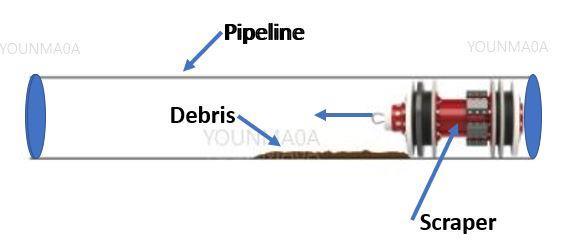
The first operation during pre-commissioning is to mechanically clean and gauge the internal of the pipeline. The purpose of these activities is to prepare the line for hydrotesting and to ensure that the line is clean for the use of inspection tools, or that at least that debris which was left over from the construction phase (potentially damaging to the pipeline or associated process equipment) is cleared out. The proponent of the line will generally set criteria for cleanliness depending on the intended purpose of the line. As would normally be the case in the operational use of Scrapers for pipeline cleaning, the Scrapers will be selected based on their duty and effectiveness based on the quantities of debris collected into the receiving trap. Brush Scrapers are normally selected if some time has passed between the line being laid and this mechanical cleaning operation, in order to produce a more aggressive cleaning action. One or more trains of scrapers would be run depending on the quantities of debris being produced, and this would continue until the amount of debris meets the criteria set for the pipeline, Figure 1.
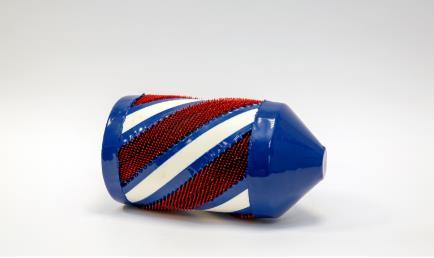
A steel pipeline with no internal coating is normally cleanedwith a Scraper similar to thatshown in Figure 2. Brush Scrapers will rub the internal surface of the pipeline, removing rust and loose mill scale, while the Scraper disks move the debris along the pipeline. Brush scrapers with magnets are also used to remove mill scales from the internal walls of the pipeline
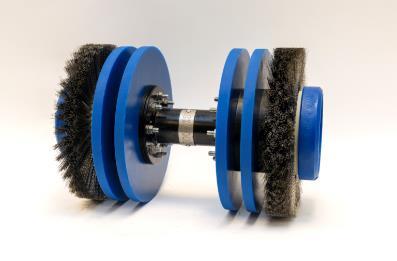
Once cleaning is completed, the next stage will often be to run a gauging plate scraper or caliper Scraper. The main purpose of this operation is to ensure and prove the ovality and roundness of the pipeline in addition to ensuring that there are no protruding defects or dents from welding and construction that might hinder the launching of future scrapers inside the line.
International Journal of Engineering Research and Reviews ISSN 2348-697X (Online)

Vol. 10, Issue 3, pp: (33-37), Month: July - September 2022, Available at: www.researchpublish.com
Normally, the gauging scraper is equipped with a thin aluminum plate slightly smaller than the internal diameter of the pipeline (generally 95 – 97% of the pipeline internal diameter) and has grooves to allow theplate to bend and show at which angle the dent is located at. Figure 3.
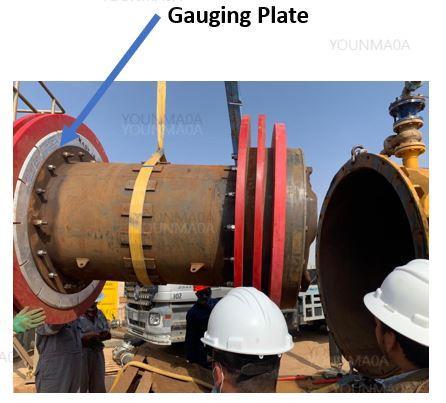
Another method to detect and locate any dents or intrusions into the pipeline is to utilize an electronic caliper Scraper which is capable of providing more detailed information regarding the position and nature of the restriction. The original electronic caliper tools consisted of multiple arms in contact with the pipe wall coupled to a single sensor, providing data on the maximum size of any intrusion into the line. Experienced operators could determine the nature of the out-of-roundness feature encountered and an approximate distance from the end of the line. More recent tools (e.g. Figure 4) have independent sensors on each arm and can provide more detailed profile information on the defect and usually an indication of whether to expect the feature to be located on the top or bottom of the line.
The main operation of hydrotesting is to fill the pipeline with quality and treated fresh water. The specification for filling water is that less than 0.2% of the pipeline volume can be air after the filling operation is complete. The reason for this is that the compressibility of the air has a significant effect on the hydrotest operation, and can produce invalid results in some cases. For this reason, it is not generally possible to control flooding using only a single Scraper. Normally, it’s a good practice to use Scrapers that have good sealing characteristics, and to have two or more Scrapers in the train. This train of scrapers will usually be designed in a relatively conservative way, since the costs of having to repeat the hydrotest due to any failure may be significant and expensive
After securing the water source and all necessary pumps and accessories, the filling of the pipeline with water is started. Normally, the water is filled between two scrapers (Figure 5) at a speed that is not too low or too high which can lead to situations where excessive bypass of water around scraper may occur.
International Journal of Engineering Research and Reviews ISSN 2348-697X (Online)
Vol. 10, Issue 3, pp: (33-37), Month: July - September 2022, Available at: www.researchpublish.com
Water filling of larger diameter pipelines can be very difficult and sufficient pumps should be available and spare capacity will be needed to provide coverage for potential breakdowns
After the line has been successfully filled and stabilized, the pipeline is brought up to test pressure, to:
• verify the strength of the pipeline, and its ability to withstand the operating pressure
• verify that there are no significant leaks
• relieve some of the stresses potentially induced during welding and construction.
To achieve the mentioned points above, the normal hydrotest procedure and standards require the below tests to be conducted on each pipeline segment:
• Strength Test: A pressure test at an internal pressure determined in accordance with standard and the applicable code to verify the integrity of the pipeline for service at the design pressure.
• Tightness Test: A pressure test to ensure tightness of the piping system (i.e., no leaks in the system) at a test pressure.
Once the pipeline is tested and the results are acceptable to all responsible parties, then the water inside the line should either be removed for disposal or for possible re-use in the other pipeline sections. To dispose the hydrotest water, strict compliance to environmental procedures should be followed because the hydrotest water is normally treated with chemicals to protect the pipeline from corrosion and bacteria growth.
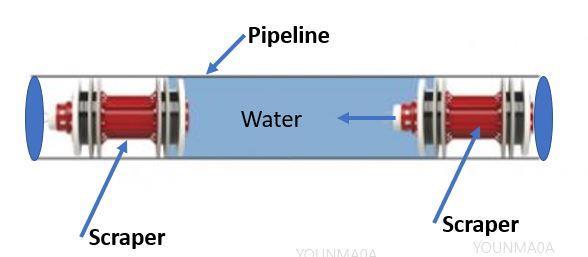
After the hydrotest is complete, the pipeline may be left full of the (treated) water for some time to be transferred and reused in the next sections. Otherwise, this treated test water will be disposed in an environmentally approved evaporation ponds in order to protect against environmental contamination and expose animals for chemically treated water. To dewater the pipeline, a single scraper will be used to push the water out as shown in Figure 6.
For gas pipelines, the presence of residual water inside the pipeline can have very serious consequences in terms of the potential for corrosion to occur For this reason, normally multiple scrapers are utilized in a train to dewater the line This train consists of a number of bi-di Scrapers intended to sweep the bulk of the liquid out of the line to move this train of scrapers, a considerable pressure is provided to overcome the significant hydrostatic head and friction forces in the line.
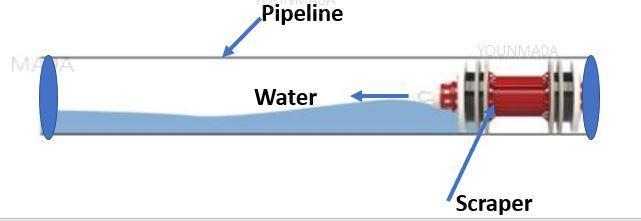
International Journal of Engineering Research and Reviews ISSN 2348-697X (Online)
Vol. 10, Issue 3, pp: (33-37), Month: July - September 2022, Available at: www.researchpublish.com
Several techniques are normally utilized to reduce the residual amount of water and moisture inside the pipeline like airdrying and vacuum drying. Normally, a series of foam and Bi-Directional scrapers are run inside the line during airdrying operation. These scrapers will swab water off the pipe wall by absorbing it; and they also push the water out in front of the Scrapers. Once most of the water has been removed, a final stage of drying will proceed by purging the pipeline with dry air or nitrogen. Another alternative to this is to run a scrapper train with a batch of chemical absorbing agent to remove all possible moisture inside the line.
After the dewatering operation, the newly constructed pipelines shall be turned over to the proponent in a clean condition. To accomplish this, pipelines shall be chemically cleaned to remove any deposits or moisture that might contribute to the possible formation of the most common fouling o pipelines which is Black Powder. A train of scrapers is normally launched carrying chemicals in between scarpers to remove any soluble scales, moisture, grease, or foreign material from the walls of the pipeline. After chemical cleaning, the pipeline should be dried and laid up with nitrogen and is now ready for startup and operation.
The Master Gas System MGS phase 2 pipeline is currently undergoing all the above-mentioned pre-commissioning processes. These pipelines will be the most effective mean of transporting gas to various regions in the Kingdom. After construction of the pipeline, these pre-commissioning activities are very essential to ensure that the pipeline is clean and ready for use. Mechanical cleaning of debris, hydrotesting to check strength, dewatering of used chemically treated water, and chemical cleaning and preservation are critical activities that must be performed effectively before the pipeline is put in service. Utilization of different types of scrapers like foam, bi-directional, brush, intelligent, etc. are some critical tools to help in the pre-commissioning stage. After completion of all these activities, the pipeline will be re-instated with all required valves and will be preserved with nitrogen to make it ready for operation use.
[1] Robert Davidson, An Introduction to Pipeline Pigging, Halliburton Pipeline and Process Services, 2002
[2] Proceedings of the 2016 International Conference on Industrial Engineering and Operations Management Detroit, Michigan, USA, September 23-25, 2016
[3] The Process Piping Technical Knowledge, Introduction to Pigging in Pipeline, https://www.theprocesspiping.com/
[4] Cordell, J.; Vanzant, H., The Pipeline Pigging Handbook. 2003
[5] Hiltscher G.; Muhlthaler, J.; Smits, J., Industrial Pigging Technology. 2003
[6] Adegboye, M.A.; Fung, W.; Karnik A., Recent Advances in Pipeline Monitoring and Oil Leakage Detection Technologies. 2019